Clinician Turned Patient
It went wrong, or did it? – read extracts from the author’s new book out now …
A New Patient Handbook on Rotator Cuff Tear diagnosis and treatment
Published by Buspencilcase Communications and available from Amazon – paperback (£5.99) now or pr-order the e-book (£2.99) for July 1st 2024.
Pocket-sized (5x8in) with 112 pages, over 35 images, and resource links. Comprehensive content and index.
BUY NOW

Answering all your questions in one place
Selected Extracts
Shoulder pain is a musculoskeletal problem where daily pain had developed for some months in my left shoulder and biceps muscle. Writing about shoulders on a foot website may seem odd, but consultingfootpain likes to be inclusive. While I am a health journalist and have retired from clinical practice—the narrative offers two points of objectivity – a need to know my problem and how to fix it. The subtext to the question is, is this the proper treatment, and should I do more?
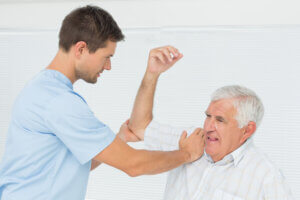
Shoulder pain is joint in the 60+ age group but can arise earlier. Stock Photo of a physiotherapist assisting a patient.
The internet offers plenty of information with videos and explanations, but what patients like is that individual, objective discussion. As a clinician cum patient, I hope I can offer both, take you behind the scenes and provide objective advice. (Note any images shown bear no relationship to persons in this article.)
When do you realise something is not correct?
Case History of a Shoulder Injury
As a keen fitness person, I have a subscription to the local fitness gym centre. My left shoulder started to hurt after undertaking some of my routines. The embarrassment came because I had written a series on keeping safe when undergoing fitness. Now I had a problem! The chin dip exercise had exacerbated a hidden problem.

Chin dip with weighted resistance
As a lower limb musculoskeletal specialist, a diagnosis was required. Unless a GP practice has a physician trained in orthopaedics, you will receive the ‘ibuprofen’ mantra – ‘take painkillers, and if the problem doesn’t improve, come back!’
Taping
Taping or strapping provides an excellent way to reduce joint movement and tendon traction (pull) and will support a muscle or a muscle group. Taping is usually applied directly to the skin. Ideally, this should only be used briefly to avoid skin damage. A support brace can be valuable, and I purchased something similar to the illustrated shoulder strap —a gel ice pack fitted into a pocket on the inside skin side. In my case, I had limited benefits owing to the extent of my shoulder damage. The brace was uncomfortable, and when I tried taping, it worked well enough. However, even though it had been used for a few days, the top layer of skin was severely damaged, and there was a slight scar weeks later.
Finding a Physiotherapist
With little to guide me, I found a private physiotherapist ‘the usual way’ – online. A consultation with the physiotherapist tested my range of movement and muscle power. The diagnosis was tendonitis of the biceps tendon and irritation of supraspinatus.
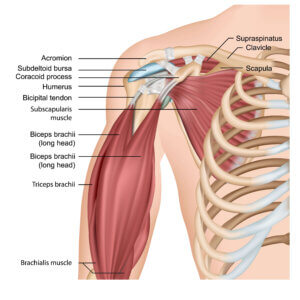
The anatomy shows two upper tendons marked as long heads. Four rotator cuff muscles allow arm movement at the shoulder away from the body (trunk). The supraspinatus works with the deltoid muscle to perform similar movements as the arm moves further. These muscles all work together. When one fails, another compensates and often hurts, leading to symptoms.
In brief, I had a rotator cuff problem – common enough, but I was surprised as I thought I was pretty fit and kept this muscle reasonably exercised. It would not be until later that I identified the cause. It would not be the exercise alone; it was just an additional factor.
Armed with a diagnosis, I was delighted to start treatment. The physio started with laser treatment and massage to release the tension. I also had a series of exercises linked to an online video programme specific to my needs.
A package of care
My physiotherapist hit treatment session number 3 of 6, as I had opted for a fixed package of care. I asked if some progress would be visible after the third treatment and was given a moderate answer that perhaps suggested ‘yes’. By the sixth treatment, any improvement lasted around 12-24 hours. The physio had not appreciated the level of damage and the fact no amount of physiotherapy would cure my problem! With surgery now inevitable, I describe the journey between July 2023 and the end of June 2024.
Thanks for reading ‘Shoulder Pain – Rotator Cuff Repair’
- Illustrated with behind-the-scenes comments from a former consultant.
- I was making decisions.
- We are confronting the problems with surgery.
- It is knowing the right questions to ask.
- Easy language without heavy medical terminology.
- How to obtain treatment.
- NHS or independent marketplace?
- Trustworthy information is all in one place with links.
- No adverts.
Order today from Amazon Books
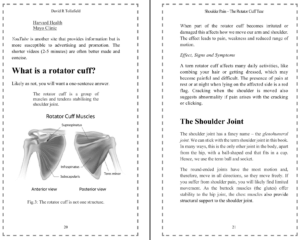

Other patient-related books and guides by the same author
Bunion Behind the Scenes
&
Morton’s Neuroma: the Patient’s Book
Published by Busypencilcase Communications (Est. 2015) for consultingfootpain

Issued June 15th 2024
David is a former podiatric surgeon and consultant who has worked in eight NHS and private hospitals and was a former Dean of the Faculty of Surgery for the Royal College of Podiatry (2012-2014). He started his career as a formal journalist and author in 2017 with over ten published books. The rotator cuff is a patient guide; his most recent book was published June-July 2024.

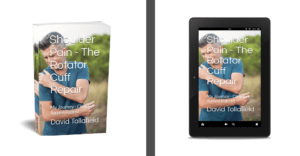
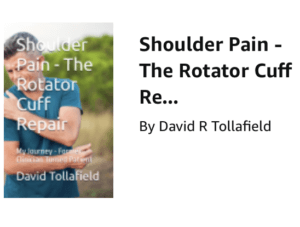
As usual, the thoughts of the patient and the explanation of how the diagnosis arrived were well presented in an easy to understand vernacular. The illustrations were very helpful and the affected sites easily recognized.
Many thanks Dr Stepanczuk for reading my article
As usual, I found the patient thoughts and the way the diagnosis arrived presented in an easy to understand vernacular. The illustrations were clear, helpful and the affected sites were readily recognizable.